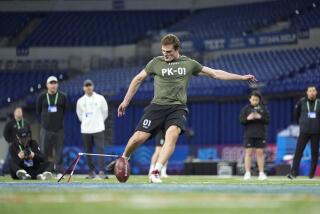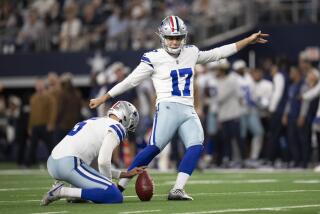Agajanian Made It by Half a Foot : Kicker Beat Bad Injury to Work 40 Years in NFL
- Share via
Imagine being an airline pilot who goes blind, a musician who goes deaf and you have some idea of the nightmare Ben Agajanian faced nearly half a century ago.
It was 1941 and Agajanian, a place kicker/end for the University of New Mexico, had a summer job working at a Coca-Cola plant. Seated atop a barrel of syrup headed upward in a freight elevator, Agajanian was carelessly dangling a leg over the edge of the elevator shaft, the very same leg he depended on to boot footballs.
Between floors, a ledge jutted out from the side. By the time Agajanian saw it, it was too late. His foot smashed into the ledge with sickening force. There was blood everywhere.
Agajanian said he calmly got himself to a hospital, hopping into the waiting room. Doctors took one look and decided there was no way to save his toes.
What about football, he wanted to know.
Forget football, doctors told him. Just be thankful if you can walk normally.
Not Ben Agajanian, who has become a familiar figure in Thousand Oaks during the summer for nearly two decades as the kicking coach for the Dallas Cowboys.
“Well if you are going to have to amputate the toes,” Agajanian said, “then square ‘em off. Don’t let one stick up. This way, I’ll kick better.”
Doctors didn’t think it would make much difference, but they did as Agajanian requested. When the operation was finished, only squared-off nubs were left on his right foot.
Just as he had predicted, he was soon back on a field kicking footballs. A right-footed kicker in the past, he tried using his left foot, but couldn’t do anything. So, he went back to what was left of his right foot.
It wasn’t easy. The first six times he connected, pain shot through his body. He took off his shoe and blood spilled out of his sock.
No matter. He kept kicking. And soon, numbness set in and the bleeding stopped.
The next step was to get a better shoe. He had tried stuffing paper and two extra pairs of socks into the front of his old shoe in the space formerly occupied by his toes, but that didn’t work. So he found a shoemaker who made him a new shoe with a squared-off toe and a leather strip at the end, and suddenly he was kicking better than ever.
For want of some toes, a career was launched.
He made honorable mention All-American in his senior year at New Mexico, then signed with the Hollywood Bears of the Pacific Coast Pro League in 1942. The nation was at war, however, and Agajanian wanted to serve. Rated 4F because of his old foot injury, he nevertheless enlisted and was stationed in Southern California. That allowed him to get away on weekends to kick for several teams in the PCPL over the next few seasons--the Los Angeles Bulldogs, Santa Ana Flyers and San Diego Bombers--before finally being drafted into the National Football League by the Philadelphia Eagles in 1945. After just two games, he was traded to the Pittsburgh Steelers.
He was still a lineman as well as a kicker until he broke his arm soon after arriving in Pittsburgh.
The Steelers decided to keep him solely to kick. This was in an era when placekickers were about one step above water boys on the esteem scale in pro football. Settling for a field goal was a last resort in those days, a sign of failure by the offense.
But the Steelers took a chance and Agajanian quickly created his own special stomping grounds. He was asked to kick only four field goals the rest of the year, but made them all. The age of the kicking specialist was born.
It wasn’t a role Agajanian always relished, especially during the 1949 season when he found himself on a New York Giants club that often considered more than one field goal per game an unnecessary intrusion into the offensive flow of the game.
“Lou Groza was playing with the Cleveland Browns in those days and he was appreciated,” Agajanian says. “I was so jealous because my coaches thought I was just excess baggage. I told them, ‘Well then, you ought to dump me.’ ”
It was Agajanian who did the dumping. Unhappy with his situation, he would return to Southern California to devote himself to his various enterprises--including an oil business and sporting goods and discount stores--only to be lured out of retirement again and again.
He kicked for the Los Angeles Dons in the now-defunct All-American Conference. When that league folded, Agajanian returned to the NFL with the Giants. He retired in 1950, but three years later, Bob Waterfield was ending his career with the Rams and they needed a kicker. So Agajanian again laced up his squared-off shoe.
Teams would let him skip training camp, skip weekday practices and just fly in for games. The sport that had once mocked his special talent now courted him from coast to coast. In 1961, at the age of 42, he kicked a 51-yard field goal, a Cotton Bowl record, for the Dallas Texans of the American Football League and finished the year on the NFL champion Green Bay Packers.
When he finally retired for good at age 45, he had spent 17 seasons in the pro game, kicking for 13 teams in four different leagues. He was the first to turn the laces of the football to the front, which took the pressure off his toes while also allowing the ball to sail farther. He was the first to take three steps back and two over before kicking, a standard prekick ritual for today’s generation of soccer-style kickers. He was the first to get his offensive line to employ the double bump method of blocking to cut down the odds of having one of his kicks wind up in the arms of an onrushing defender.
The Ben Agajanian kicking clinic began a quarter of a century ago. Young kickers would ask him to work with them, and Agajanian had a standard response.
“I work out in Long Beach on Wednesday afternoons,” he would tell them. “Come on out and I’ll work with you.”
So out they came every year from March to June, some of the biggest names to ever blast a football between the goal posts. They would come as youngsters, as high school players, as college players and even after making it as professionals, and Agajanian would watch and advise them all.
He has worked with everybody from NFL kickers such as Rafael Septien, Norm Johnson, Efren Herrera and Frank Corral to John Lee, picked by the St. Louis Cardinals in this year’s draft after kicking the most career field goals in NCAA history while at UCLA. Agajanian has kickers all the way down to age 7.
“I ask for no money, no nothing,” Agajanian says. “If I get a letter thanking me, that’s my pay. Some kids come out to learn, some come out and say, ‘Where’s my scholarship?’ ”
Kevin Greene did not say anything of the sort. The Simi Valley High and Moorpark College kicker was just thrilled to be working with a legend, but before Greene was done, Agajanian had spread the word well enough to get the young kicker a scholarship. This fall, Greene will jump from kicking with Agajanian on Wednesdays to kicking for Syracuse on Saturday afternoons.
“He taught me to concentrate,” Greene says. “He made everything like a game situation. But really, there are so many good kickers around that there is pressure all the time. I feel I’m just lucky to have gotten a spot at Syracuse.”
Now 66, Uncle Ben, as the players call him, is retired.
Except for those spring afternoons in Long Beach at Long Beach State or Millikan High.
Except for the annual Ben Agajanian Kicking Camp that convenes for a one-week session in June and featured 150 kickers this year. Except for his role as the Dallas Cowboy kicking coach, a role he’s filled nearly every year since his retirement.
Agajanian’s job with the Cowboys actually will increase this year. In the past, he has worked with Dallas kickers during the club’s preseason camp at Cal Lutheran in Thousand Oaks, then made some trips to Dallas during the year. This season, Coach Tom Landry plans to have him around for the whole season.
“He is one of the premier kicking coaches in the business,” Landry says. “He keeps the kickers’ confidence up. It’s a tough job and it’s good to always have someone around to bolster their confidence.”
That also means listening to their excuses. Over the years, Agajanian has heard them all: I got a bug in my eye; I had to go to the bathroom; my shoes were too tight; my helmet was too tight ; the goal posts looked crooked; the ball was too new, too soft, too muddy.
Septien has used two of the best on his mentor. On one occasion after missing a field goal, he came back to the sidelines shaking his head and said, “Uncle Ben, the grass was too high.”
Replied Agajanian, “Rafael, we’re playing on Astroturf.”
Another time, Septien came back after a miss with an even better one.
“Uncle Ben,” he said, “I missed because the ball was upside down.”
Of course, he was talking to the man who had the greatest excuse of all every time he missed.
“What do you expect,” he could have said, “from a man with no toes?”
Amazingly enough, quite a bit. And he rarely disappointed.
More to Read
Go beyond the scoreboard
Get the latest on L.A.'s teams in the daily Sports Report newsletter.
You may occasionally receive promotional content from the Los Angeles Times.










